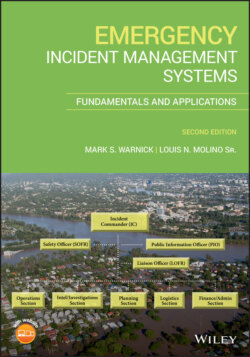Читать книгу Emergency Incident Management Systems - Mark Warnick S., Louis N. Molino Sr - Страница 38
1.10 The National Incident Management System (NIMS)
ОглавлениеIn February 2003, President George W. Bush issued Homeland Security Presidential Directive (HSPD) No. 5. This Presidential Directive was created to establish a single, comprehensive national incident management system to deal with domestic emergency incidents within the United States. HSPD‐5 (and its companion document HSPD‐8) used language that required NIMS to be used in more than just the response phase of emergencies; it required that NIMS would be used to prevent, prepare for, and respond to incidents, regardless of the size, cause, or the level of complexity. Furthermore, this Presidential Directive concluded that the system should be used in terrorist attacks, major disasters, and any other domestic emergencies, including day‐to‐day operations. The primary purpose was to ensure that all levels of government had the capacity to participate together in a collaborative, effective, and efficient manner by using a single command and management method.
NIMS is not, and was not, intended to be an operational incident management method. The operational aspect of incident management was relegated solely to ICS component. The components of NIMS were designed to integrate with ICS, thereby creating a more unified and collaborative response. The components of NIMS connected with ICS and work in harmony to form a comprehensive incident management system. While ICS is a component of NIMS, it is not the only component. The totality of NIMS components includes
Preparedness
Communications and Information Management
Resource Management
Command and Management
Ongoing Management and Maintenance
It is important to note that the NIMS Methods required the use of the standardized Incident Command System (ICS) for operational management of an incident. NIMS provides a core set of principles, concepts, doctrines, terminology, and organizational practices to facilitate effective, efficient, and collaborative incident management on incident of all sizes and nature. It creates and promotes improved collaboration among all stakeholders.
NIMS is appropriate across the full range of potential incidents, hazards, and impacts, and is beneficial in managing resources regardless of size, location, or complexity of the incident. It is created and managed in such a way that it improves coordination and cooperation between both public and private entities, and it is effective in a large variety of incident management activities. Perhaps the most important aspect of NIMS is that it provides a communal standard for overall incident management.
The consistent practice of NIMS initiates and maintains the groundwork for efficient and effective responses. Whether it is a single‐agency response, a multiagency, a multidisciplined, or a multijurisdictional response to a natural disaster or terrorism, NIMS is a way for everyone to be on the same page. If a single‐agency response escalates into a multijurisdictional response, those entities who have integrated NIMS into their planning and incident management structure have a unique advantage. They can come to an incident after being dispatched with little notice, and still understand the overarching procedures and protocols governing the response. Any personnel dispatched know, from the minute they are called, what the expectation is for equipment and personnel. The real beauty and actual utility of the system is the harmony in preparedness and response efforts which permits diverse entities to easily and comfortably integrate resources, and if needed to be able to quickly establish Unified Command (explained in Chapter 7) during a chaotic time of an incident where everyone needs a seat at the table.
